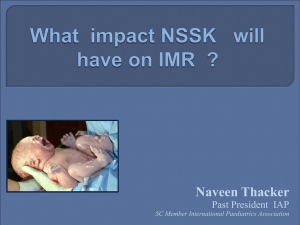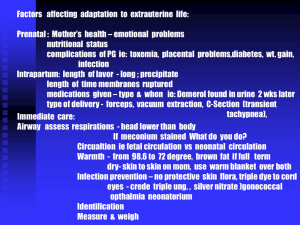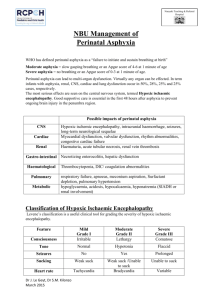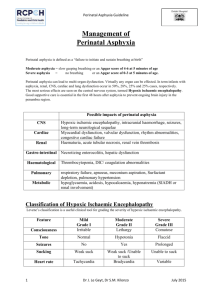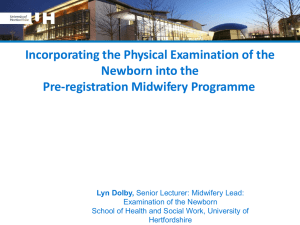Prevention of newborn asphyxia through improved labor
advertisement
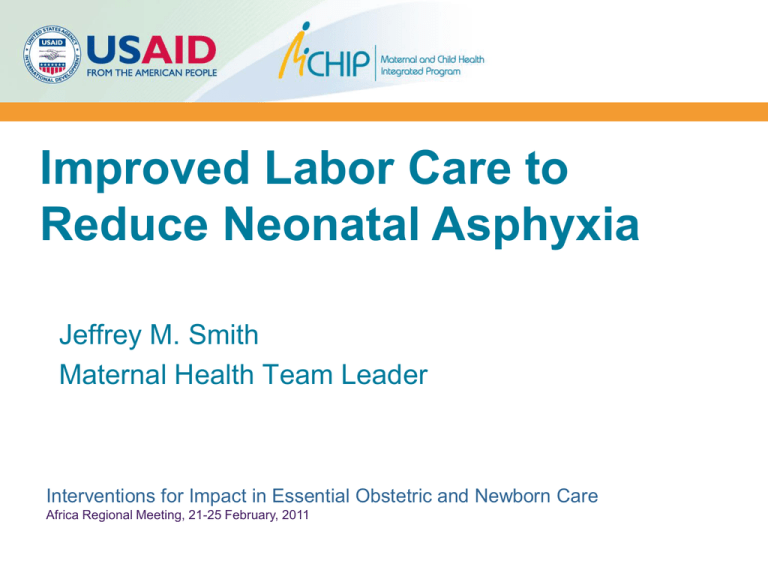
Improved Labor Care to Reduce Neonatal Asphyxia Jeffrey M. Smith Maternal Health Team Leader Interventions for Impact in Essential Obstetric and Newborn Care Africa Regional Meeting, 21-25 February, 2011 Afghanistan 2002 Maternal Mortality Survey showed an MMR of 1600 MD / 100 000 LB 77% of newborns died if they were born to mothers who died Newborn mortality and health are directly linked to maternal mortality and health Bartlett, et al. 2005 2 Parent Death & Child Survival in Bangladesh Cumulative probability of survival of child to age 10 years Mother alive: 88.9% Mother dead: 23.8% Father alive: 88.6% Father dead: 89.3% Ronsmans LANCET 2010 3 Improved maternal care will result in improved newborn outcomes Use of evidence-based labor and delivery practices will achieve: Reduced maternal and newborn morbidity and mortality Improved quality of care Respect for women and newborns 4 Obstetrics/Midwifery is watchful waiting Obstetrics – From the Latin obstare: to stand by To wait, to be vigilant, to be ready Midwife With women Watchful waiting • For mother, for newborn • For complications • Interventions when proven and necessary 5 Intrapartum Care to Prevent Asphyxia: Good maternal and newborn care: Use partograph for vigilant labor monitoring Allow companionship during labor and birth Ensure supportive 2nd stage management based on fetal and maternal condition Avoid incorrect practices Manage pre-eclampsia correctly Ensure skilled attendance at birth to prevent and manage asphyxia 6 Use of the Partograph Partograph: Drugs provided • Including oxytocin Amniotic fluid condition Fetal heart rate Use of Partograph combines all needed documentation Ob and Peds leaders should ensure its use 7 Intrapartum care to prevent asphyxia Use of the Partograph How does the Partograph prevent asphyxia? Identify abnormal heart rate patterns Prevent prolonged labor • Prevents unnecessary augmentation using oxytocin • Prevents infection Ensure timely Caesarean Prevent hyperstimulation Encourage greater vigilance 8 EMOTIONAL SUPPORT DURING LABOR 14 studies 5021 women Use of analgesia/anesthesia during labor Electronic fetal monitoring Problems during labor Prolonged labor Operative vaginal birth Episiotomy Perineal trauma Cesarean Five-minute Apgar <7 Newborn need for oxygen Admission of Newborn to Newborn Care Unit Prolonged hospital stay for newborn Newborn sepsis Severe pain during labor Labor worse than expected Struggle in enduring birth Feeling of tension and anxiety during labor Poor labor experience Struggle with medical staff Lack of exclusive breastfeeding at 6 weeks Severe postpartum depression at 6 weeks Relative Risk (95%CI) 0.79 (0.75-0.84) 0.78 (0.58-1.07) 0.48 (0.36-0.63) 0.05 (0.00-0.86) 0.81 (0.72-0.92) 0.66 (0.48-0.92) 0.95 (0.88-1.03) 0.80 (0.68-0.93) 0.50 (0.29-0.89) 0.94 (0.59-1.50) 0.87 (0.68-1.11) 0.61 (0.37-1.01) 0.45 (0.21-0.96) 1.01 (0.93-1.10) 0.77 (0.62-0.97) 0.74 (0.55-1.00) 0.80 (0.63-1.03) 0.72 (0.57-0.91) 1.07 (0.51-2.26) 0.82 (0.74-0.91) 0.03 (0.00-0.52) 9 .1 .2 1 5 10 Intrapartum care to prevent asphyxia Pre-Eclampsia Management Undiagnosed/inadequately managed severe pre-eclampsia results in Maternal seizure Severe hypertension Emergency Caesarean Neonatal Asphyxia Proper management of severe PE / Eclampsia Prevent seizures: Mg SO4 Treat hypertension: anti-hypertensives Ensure timely delivery Increase obstetrical monitoring – not darkness and quiet at the end of the corridor 10 Intrapartum care to prevent asphyxia Second stage labor management Continue monitoring of fetal heart Check every 5 minutes, record every 30 min. If fetal heart rate is normal, no need to rush delivery Do NOT urge the woman to immediately and continuously bear down Allow some descent – makes pushing easier Rest in between pushes allows oxygenated blood to reach placenta/fetus Do NOT push on fundus 11 Intrapartum care to prevent asphyxia Alternative positions Supine/lithotomy: uterus compresses vessels reduced uterine blood flow 1st stage labor: left side, standing, walking 2nd stage labor: squatting, sitting, hands & knees 12 Intrapartum care to prevent asphyxia Labor Management Adequate hydration and nutrition during labor essential Dehydration compromises uterine blood flow Allow women to drink freely and take small amounts of food during labor 13 Intrapartum care to prevent asphyxia Labor augmentation Medical decision based on medical reasons Use Partograph to diagnose protracted active phase Provide oxytocin using protocols in MCPC Do NOT allow uncontrolled oxytocin for augmentation Causes tetanic uterine contractions Complete restriction of blood flow to fetus 14 Other supportive practices Clean birthing practices/infection prevention Infected babies don’t breathe well Doing procedures right! Vacuum extraction and breech delivery Twin delivery – management of 2nd twin Keep normal births normal! 15 Let Babies Breathe! Prevent asphyxia Monitor with partograph Companionship, hydration, position Prevent eclampsia No uncontrolled oxytocin Supportive 2nd stage based on fetal condition 16 Thank you! wwww.mchip.net Follow us on:


